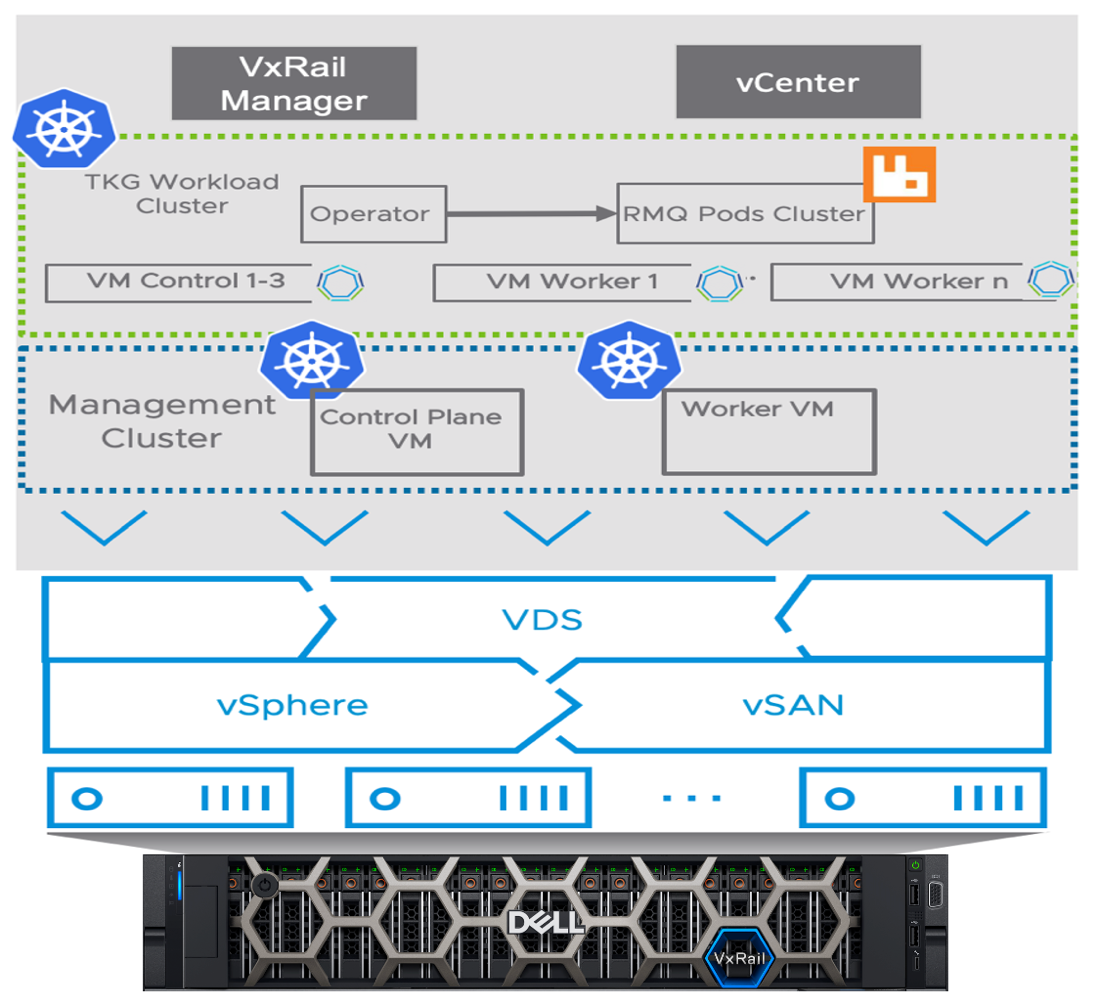VMware RabbitMQ Solution Configuration
Configuration
Architecture
In our solution, we deployed the VMware RabbitMQ test environment using Tanzu Kubernetes Grid on a 4-node VxRail P570F cluster. Firstly, we deployed the Tanzu Kubernetes Grid management cluster with Tanzu CLI by either an installer UI or a configuration file. Refer to Prepare to deploy Management clusters to vSphere for more details. After you deploy a management cluster to vSphere, use the Tanzu CLI to deploy the Tanzu Kubernetes Grid workload cluster. The Tanzu Kubernetes cluster is deployed through a configuration file with customized variables for cluster settings and scalability. Refer to Deploy Tanzu Kubernetes Clusters to vSphere for more details. To support the VMware RabbitMQ Streams deployment, we recommend configuring a Tanzu Kubernetes Grid workload cluster with at least 3 nodes; each node is requested with a minimum value of 16 vCPU, 64GB memory, and 1TB disk space.

Figure 1: VMware RabbitMQ Running on Tanzu Kubernetes Grid
Now you can deploy VMware RabbitMQ for Kubernetes to a TKG workload cluster. You can pull all the VMware RabbitMQ components of the package from the registry. Then you will install the package to install the VMware RabbitMQ Operator to your cluster. After the installation is completed, you can now create a VMware RabbitMQ cluster via the configuration file.
Hardware Resource
Table 1: Hardware Configuration for VxRail
|
PROPERTY |
SPECIFICATION |
|
VxRail node |
VxRail P570F |
|
CPU |
2 x Intel(R) Xeon(R) Platinum 6148 CPU @ 2.50GHz, 28 core each |
|
RAM |
512GB |
|
Network adapter |
2 x Broadcom BCM57414 NetXtreme-E 10Gb/25Gb RDMA Ethernet Controller |
|
Storage adapter |
1 x Dell HBA330 Adapter |
|
Disks |
Cache - 2 x 800GB Write Intensive SAS SSDs Capacity - 8 x 3.84TB Read Intensive SAS SSDs |
Software Resource
Table 2: Software Resources
|
Software |
Version |
Purpose |
|
VMware vSphere |
7.0 U3c |
VMware vSphere is a suite of products: vCenter Server and ESXi. |
|
Dell EMC VxRail HCI System Software |
7.0.241-27194942 |
Turnkey Hyperconverged Infrastructure for hybrid cloud. |
|
Tanzu RabbitMQ for Kubernetes |
1.2.1 |
Based on the widely popular open source RabbitMQ messaging system, Tanzu RabbitMQ for Kubernetes is designed to work seamlessly with Tanzu and also run on any certified Kubernetes distribution. |
|
Tanzu CLI |
V1.5.2 |
Command line interface that allows deploying CNCF conformant Kubernetes clusters to vSphere and other cloud infrastructure. |
|
Kubernetes |
V1.22.5
|
Kubernetes is an open-source system for automating deployment, scaling, and management of containerized applications. |
|
Kubernetes OVA for Tanzu Kubernetes Grid |
Ubuntu-2004-kube-v1.22.5+vmware.1 |
A base image template for the Kubernetes Operating System of Tanzu Kubernetes Grid management and workload clusters. |
|
RabbitMQ PerfTest |
V2.16.0 |
A throughput testing tool that is based on the Java client and can be configured to simulate basic workloads and more advanced workloads as well. |
|
RabbitMQ Stream Java Client |
V0.5.0 |
A Java library to communicate with the RabbitMQ Stream Plugin. It contains a performance tool to allow creating and deleting streams as well as publishing to and consuming from these streams to test the performance. |
Table 3. VM Configuration
|
VM Role |
vCPU |
Memory (GB) |
Storage (GB) |
VM Count |
|
Tanzu Kubernetes Grid Management cluster – Control Plane VM |
2 |
4 |
20 |
1 |
|
Tanzu Kubernetes Grid Management cluster – Worker node VM |
2 |
4 |
20 |
1 |
|
Tanzu Kubernetes Grid Workload cluster – Control Plane VM |
4 |
32 |
120 |
3 |
|
Tanzu Kubernetes Grid Workload cluster – Worker node VM |
20 |
72 |
500 |
3 |
Check out the solution Home Page for more information.
Previous page: Technical Component
Next page: VMware RabbitMQ Best Practice
